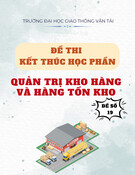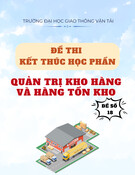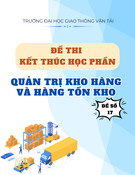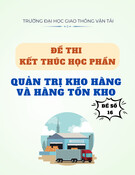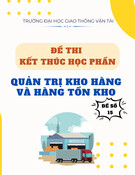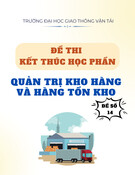
CAN THO JOURNAL OF SCIENCE AND TECHNOLOGY - No.05 - February, 2025
97
YOUNG PEOPLE’S AWARENESS OF CIRCULAR ECONOMY:
THE CASE WITH ECONOMIC STUDENTS AT CAN THO
UNIVERSITY OF TECHNOLOGY
Nguyen Thi Ly Phuong
1
, and Pham Thi Be Nam
1
1Can Tho University of Science and Technology
Email: ntlphuong@ctuet.edu.vn
ARTICLE INFO
Received: 30/11/2024
Revised: 18/02/2025
Accepted: 20/02/2025
Keywords: Awareness, Circular
economy, youth, Vietnam
ABSTRACT
Awareness precedes action. One must become aware of
something before attending to it (Graziano & Webb, 2015), and
then to actions. Similarly, a full awareness of the circular
economy (CE) could help make its implementation in an
economy more efficient. However, up to now in Vietnam, CE is
still a new concept, and there have not been many studies
investigating the public’s awareness of CE, especially among
young people. This study, using descriptive statistics with 226
survey samples of economics students at Can Tho University of
Technology, will describe the current awareness of young
people about CE. The results show that young people's
awareness of CE is still quite low. In addition, green purchases
(one of the identifying signs of CE) among young people are not
yet popular and depend heavily on price factors. These results
may provide good indicators to
competence agencies
in
attempts to raise awareness and responsibility of young people
about CE.
1. INTRODUCTION
The term “circular economy” was first
used in Western literature in the 1980s
(Pearce & Turner 1990). Then, economies
around the world have adopted the Circular
Economy in their sustainable development.
For example, the German government enacted
“the Closed Substance Cycle and Waste
Management Act” in 1996, which provided a
closed cycle waste management and ensured
environmentally compatible waste disposal
(Su et al. 2013). Also, the Japanese
government established a comprehensive
legislative system to promote the creation of a
recycling-oriented society through Eco-town
projects in 1997 (Dong et al., 2016; Berkel et
al., 2009). The Chinese government has
adopted a Circular Economy strategy to
decouple economic growth, resource use, and
environmental degradation since around the
2000s (Geng et al., 2016; Liu et al., 2009).
Not surprisingly, the circular economy is a
very new concept in Vietnam (Nguyen et al.,
2022). Following Germany and Japan - the
pioneers in systematic efforts to implement
the CE (The World Bank, 2009), the
Vietnamese government signed “The Circular
Economy Development Project in Vietnam”
in 2022. And the Government has just been
filing the Regulatory Sandbox of the Project.
Therefore, the public awareness of CE is still
elementary in Vietnam. Vietnamese,
especially young customers, have noted green
purchasing (Hoang & Nguyen, 2013; Nguyen

CAN THO JOURNAL OF SCIENCE AND TECHNOLOGY - No.05 - February, 2025
98
et al., 2017), but they still do not adequately
understand CE development.
The entities related to CE development
consist of the government, enterprises, and the
public, and the awareness of those entities in
promoting CE is important while putting CE
into practice (Xue et al., 2010). Valuable
studies related to people's environmental
awareness have been carried out by
researchers in different countries, but few
empirical studies focused on people's CE
awareness (Guo et al., 2017). In Vietnam,
many studies have focused on environmental
awareness, green purchases, or waste
management (Nguyen, 2012; Nguyen et al.,
2019; Le et al., 2019; Nguyen, 2023;
Schneider et al., 2017). There were also
papers on CE and sustainable development,
and most of the papers researched the factors
affecting the disclosure of sustainable
development (Le et al., 2019) analyzed the
impact of enterprises of the circular economy
practices (Chowdhury et al., 2022), introduced
CE form of enterprises (Clube & Tennant,
2021; Tran et al., 2022), and recommended
suitable mechanism or comprehensive
legislative system to implement CE practices
(Herrador et al., 2023; Phan et al., 2023). So
far, little research on public awareness,
especially young people’s awareness, of CE
development has been conducted in Vietnam.
Using descriptive statistics and
comparative analysis, this research offers an
overview of the awareness of young
Vietnamese about CE development. We
conducted a survey on economic students of
Can Tho University of Technology (CTUT).
The results (through 226 surveys) showed that
young people's awareness of CE was quite
low, only 11.06% of young people heard,
understood, and knew clearly about CE, while
48.23% heard but were not very interested in
CE. In addition, the survey results showed
that green purchase (one of the identifying
signs of CE) among young people was not yet
popular and depended heavily on price
factors. These results may provide good
indicators for competence agencies in
attempts to raise awareness and responsibility
of young people about CE.
Papers of public attitude or awareness of
CE have been conducted around the world.
For example, Vagner (2021) identified the
awareness and behavior of the population of
Slovakia concerning the circular economy.
They surveyed a random sample of 830
respondents. They concluded that the
environmental awareness of CE in Slovakia is
low, and they should learn from the
neighboring countries about this concept.
Almulhim and Abubakar (2021) aimed to
understand public awareness and attitudes to
CE transition in Saudi Arabia. They did a
cross-sectional, snowball-sampling-method
survey with 402 residents of the Dammam
Metropolitan Area. The questionnaire was
composed of eight closed-ended questions
with an open-ended question to solicit
additional information and consists of three
sections: assessing public attitude towards
CE part, uncovering public behavior, and
inquiring about respondents’ demographic
details. The results indicated that the
respondents had little understanding of the
CE concept due to limited awareness of the
topic. Moreover, they found that the
respondents’ level of awareness regarding
the CE transition was positively related to
their level of education.
Krajnc et al. (2022) evaluated young
people’s awareness and attitudes towards the
CE and the Green Deal (GD) in Europe. They
collected by surveying 286 young people from
five European countries. The research
framework in the paper was closely related to
the nine priorities of the EU’s GD:
biodiversity, farm-to-table, sustainable
agriculture, clean energy, sustainable industry,
construction and reconstruction, sustainable
mobility, pollution reduction, and climate

CAN THO JOURNAL OF SCIENCE AND TECHNOLOGY - No.05 - February, 2025
99
action. The analysis showed that young
people believed in the principles and priorities
of CE but did not receive enough support to
participate and implement the priorities
actively. Moreover, young people approached
the CE from different angles and showed
responsible behavior in everyday life, had
already heard about the CE’s goals and action
plan, but had been unable to reason, think, and
evaluate in an entrepreneurial way when
linking the CE to business opportunities.
There are also research papers on attitude
or awareness toward CE that were conducted
in Portuguese, UK, Ireland, and Lithuanian.
They all used questionnaires which were
composed of specific models. The results
showed that respondents became more aware
of CE and CE practices.
Meanwhile, although green economy
research is increasingly focused on Vietnam
(Bang et al., 2023; Dat et al., 2023; Nguyen,
2023), literature about CE is not abundant and
papers about public awareness of CE are rare.
Searching results for the phrase of words
“circular economy awareness in Vietnam” on the
ProQuest database yields few papers about CE.
Nguyen et al. (2022) presented the current
situation of CE inquiry and the
implementation of CE in some industrial
branches in the world and Vietnam. Currently,
Vietnam does not have a legal framework for
the circular economic development, nor does
it have a set of criteria to identify, evaluate,
summarize and provide an accurate
classification of the development level of the
CE. Therefore, it is necessary to research and
promote the implementation of the CE for the
sustainable growth and a protected
environment in Vietnam.
Tran et al. (2022) documented the factors
that impact willingness to participate in the
circular economy in Vietnam. They surveyed
431 people in Hanoi and its surrounding
provinces with a questionnaire measuring the
respondents’ level of agreement to participate
in the circular economy. They used the
structural equation model (SEM) to analyze
the data and test the complex relationships
between the variables in the model. They
found that attention to the environment, and
attitude towards intention are the factors that
have a strong impact on willingness to
participate in the circular economy. They
suggested that policymakers in Vietnam need
to pay more attention to people’s groups such
as family, friends, and mainstream media, and
need to distinguish population groups
according to different criteria comprising
occupation, education level, and age to assess
people’s willingness to participate in the CE.
So far, papers about CE and public
awareness of CE in Vietnam are still limited.
We, through this paper, wish to enrich the
literature on public awareness of CE in
Vietnam.
2. METHODOLOGY AND DATA
SAMPLE
2.1. Methodology
The authors used a survey questionnaire to
collect data describing the overview of
Vietnamese youth's awareness of CE
development. This article aims to study the
understanding, attitudes, and behaviors of
young people about CE development.
Therefore, the authors designed a
questionnaire following the structure in the
research of Xue et al. (2010), Liu et al.
(2009), Liu and Bai (2014), and Guo et al.
(2017), but restructured the questions to suit
the Vietnamese environment. Then, the
authors conducted statistical analysis to
describe the current state of young people's
awareness of CE.
To study the awareness of CE among
young people in Vietnam, the authors chose
Vietnamese university students as the research
subject. The average age of university
students in Vietnam was from 18 to 22 years
old, which was suitable to represent the youth

CAN THO JOURNAL OF SCIENCE AND TECHNOLOGY - No.05 - February, 2025
100
age. More specifically, the authors conducted
the survey with students studying economics
at (CTUT). Economic students have several
chances to learn about CE’s concepts, green
economy, and related terms. So they should
have known about CE more than the others.
Thanks to the level of awareness of
economics students about CE development,
we can infer the level of awareness of the
youth (and others) of Vietnamese in general.
In this study, the authors conducted both
qualitative and quantitative research.
Qualitative research allowed the authors to
shape the questionnaire, and quantitative
research helped the authors to understand the
current situation. Regarding qualitative
research, the authors drafted the questionnaire
according to Xue et al. (2010), Liu et al.
(2009), Liu and Bai (2014), and Guo et al.
(2017), and adjusted the questions considering
some studies on CE in Vietnam such as
Herrador et al. (2023), Tran et al. (2022), and
Tran et al. (2023). Then, the authors sent the
draft to two economic experts working at the
Institute of Socio-Economics of Can Tho
City, and two random students, asking them to
answer the survey to get their opinions on the
structure of the questionnaire, English
terminology in Vietnamese. The authors
revised the questionnaire based on the
feedback of the experts and students. Next,
the authors conducted a preliminary study by
randomly sending the questionnaire to 20
students. The authors received 12 respondents
and continued to edit the questionnaire into
the final version.
Then, the authors conducted a quantitative
study (main survey) with economics students
at (CTUT). The authors used a convenience
sampling method to conduct the survey, in
which the sample subjects were selected
mostly from economic students studying at
CTUT based on the ease of access of the
research subjects, instead of randomly
selecting from the entire population. The
students participated in the survey
independently, and their response process was
not supervised.
2.2. The data sample
Table 1. Demographic statistics
Questions Frequency Percent (%)
Male 53 23.45
Gender Female 173 76.55
Secondary school 0 0.00
College 1 0.44
Undergraduate 225 99.56
Education
Single 226 100.00
Married 0 0.00
Married Student 222 97.37
Others 4 2.63
Career Have no income 107 47.34
0-4 million VND 100 44.24
5-9 million VND 18 7.96
10-14 million VND 1 0.88
15-19 million VND 0 0.44
Income
15-19 million VND 0 0.44
Note: This table presents the demographic information of the respondents. The sample has 226
respondents in total. The percentages are calculated by dividing column 3 by 226. VND is Vietnam Dong.

CAN THO JOURNAL OF SCIENCE AND TECHNOLOGY - No.05 - February, 2025
101
Research data was collected from January
1 to May 30, 2024. The survey questionnaire
was randomly sent to 500 economics students
at CTUT via students’ e-mail. A total of 230
responses were received back (the response
rate was 46%). After the screening, we
obtained 226 appropriate responses. The
demographic statistics of the data sample are
presented in Table 1.
Table 1 presents the demographic
information of the respondents. The study
sample has a total of 226 responses, of which
the majority of the respondents are female
(76.55%); all are single and most of them are
students (99.56%). Regarding to educational
level of the survey respondents, 225
respondents are undergraduates or students.
As they are students, most of the respondents
choose no income (about 47%), or low
income of less than 4 million VND/month
(about 44%).
3. RESULTS AND DISCUSSION
3.1. The young’s understanding of CE
Table 2 presents the respondents’
understanding of CE. For question 1.1, while
only 11.06% of the respondents understood
well about CE, about 48.23% of the
respondents said they had heard about CE but
did not care about it. Another 40.71%
believed that they had no information about
CE (33.63%) or had no information about it
and did not care about it (7.08%). This result
was similar to some other studies. For
example, Liu et al. (2009) concluded that
surveyed people had limited awareness and
poor understanding of CE.
For questions 1.2 and 1.3, we tested if the
respondents were familiar with "3R", an
important term of CE including Reducing,
Reusing, and Recycling. Although more than
55.58% of the respondents thought they had
not heard of “3R”, most of the respondents
correctly chose the components of “3R”. The
statistical results showed that 70%, 48.3%,
and 40.4% of the respondents chose
Recycling, Reusing and Reducing
respectively as “3R”. We could infer from the
results that the respondents might have heard
of the concept “3R” and its components but
not cared about it.
Question 1.4 presents that most of the
students understand the important role of CE
development. Answering “Why should we
develop CE?”, 78.30% of the respondents
chose “Energy-saving and environmental
protection”, 56.10% of them chose “Reducing
costs”, and 30% of them chose “The
obligation of the national policy. So, in the
perception of young people, the
implementation of CE in the economy was not
only due to the inevitable needs of the
development trend but also due to the
requirement of the competence agencies. This
proves the important role of competence
agencies in developing CE.
Finally, question 1.5 presents the channels
through which the students got information
about CE. The results showed that most of the
students used the internet for information
(77.8%). This channel dominated the other
channels such as “Radio and TV”,
“Newspaper and Magazine”, or “Conversation
with friends”, accounting for 37%, 33.9%, and
30% respectively. Besides, not many students
read “Government Documents” or “Public-
service Announcements” for CE information
(13.9% and 9.1% respectively). This suggests
that competence
agencies need to diversify
the distribution means of information
specialized in national laws, regulations,
decrees, and so forth to reach young people
rather than just paper documents.
The results showed that economics
students at CTUT, who had many chances to
get familiar with circular economy terms,
had rather poor awareness of CE. Then, we
could infer that the awareness and
understanding of CE among young people,
who had few opportunities to learn about CE
terms, possibly even lower. However, we
hope that the awareness and understanding of

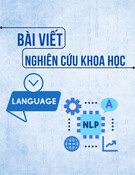

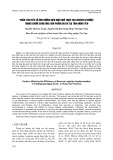
![Logistics xanh: Phát triển bền vững ở Việt Nam [Mới Nhất]](https://cdn.tailieu.vn/images/document/thumbnail/2024/20240202/vigojek/135x160/4221706863853.jpg)
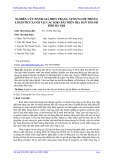
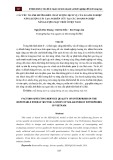
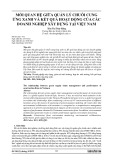
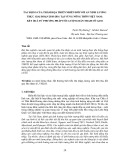

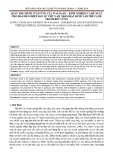







![Đề kiểm tra Quản trị logistics [mới nhất]](https://cdn.tailieu.vn/images/document/thumbnail/2025/20251015/2221002303@sv.ufm.edu.vn/135x160/35151760580355.jpg)
![Bộ câu hỏi thi vấn đáp Quản trị Logistics [năm hiện tại]](https://cdn.tailieu.vn/images/document/thumbnail/2025/20251014/baopn2005@gmail.com/135x160/40361760495274.jpg)
